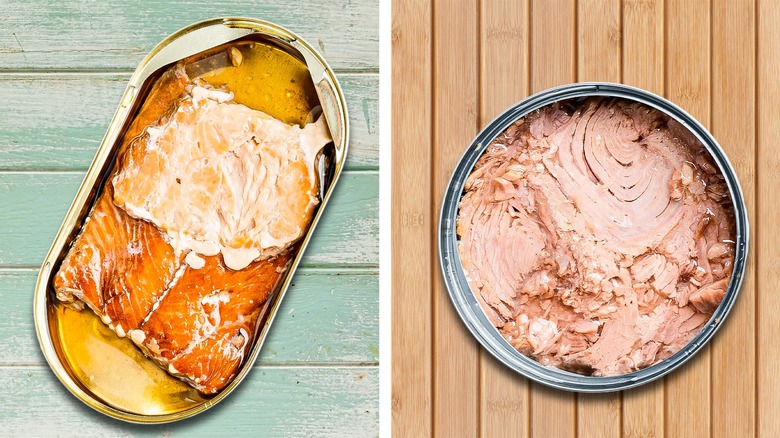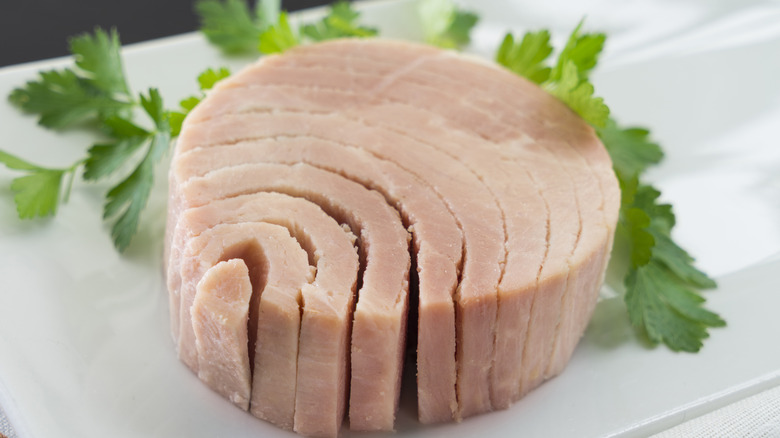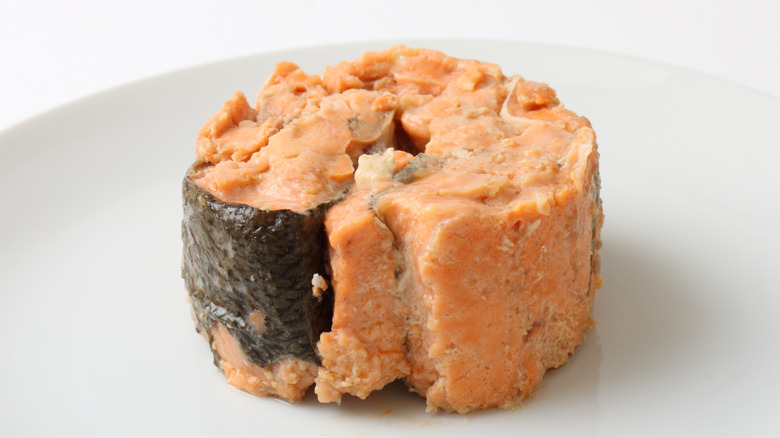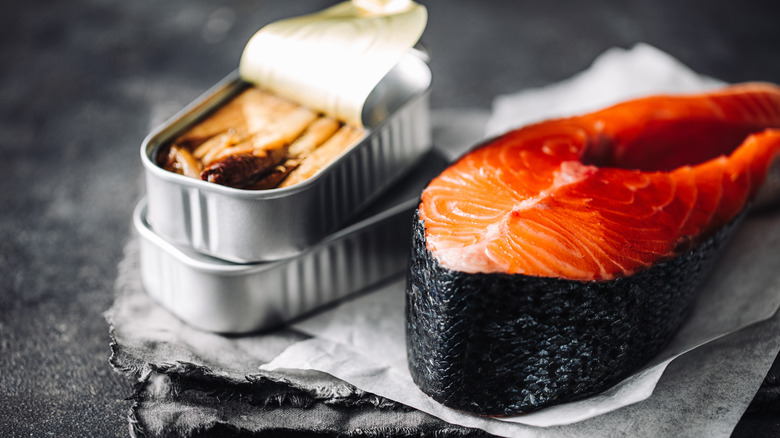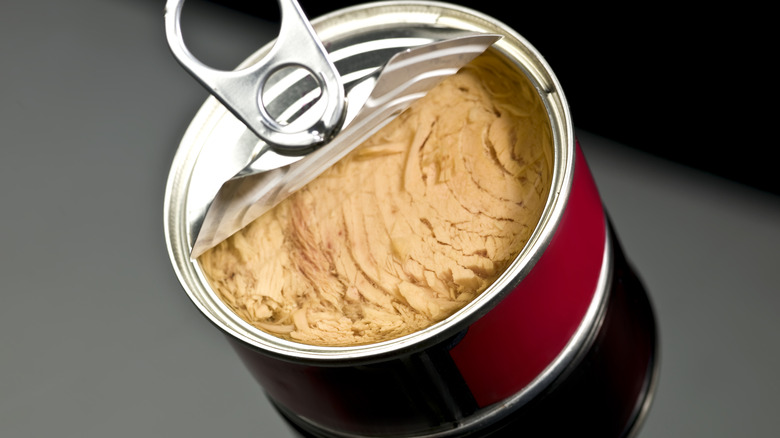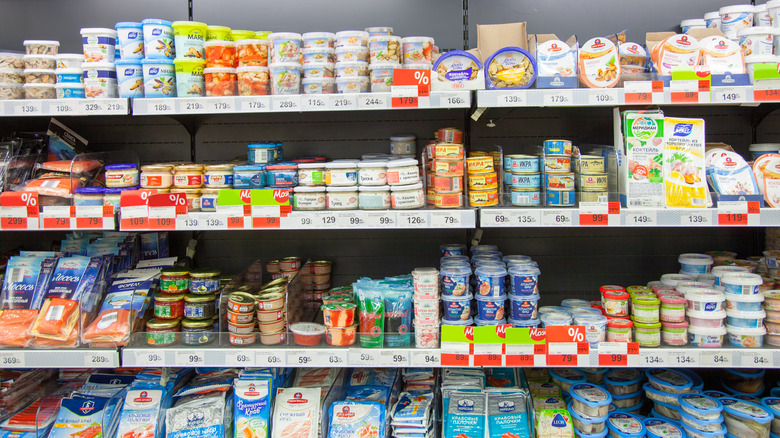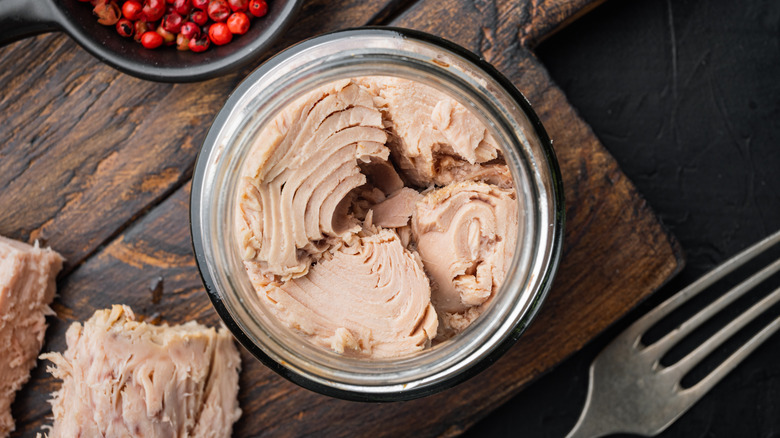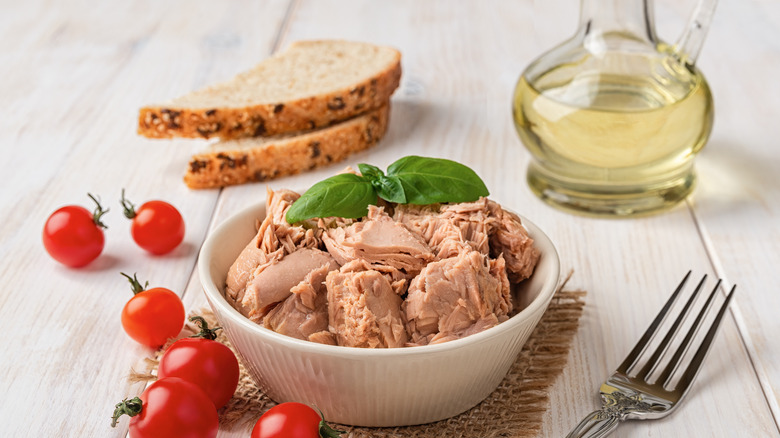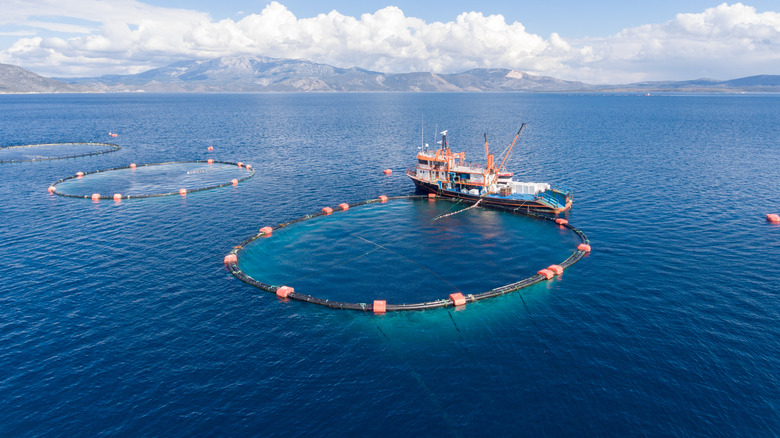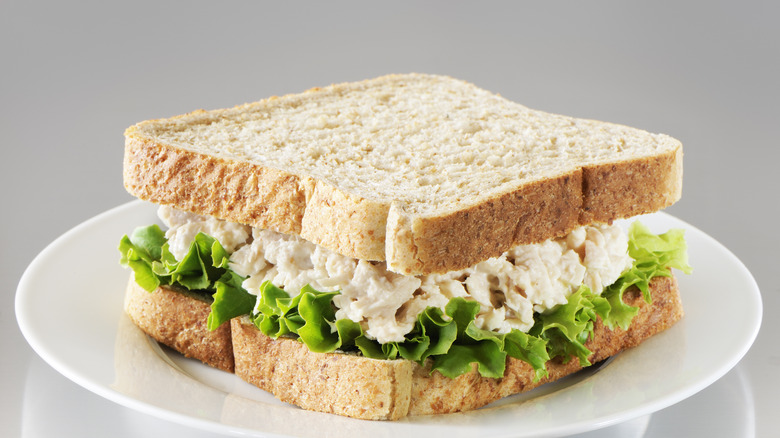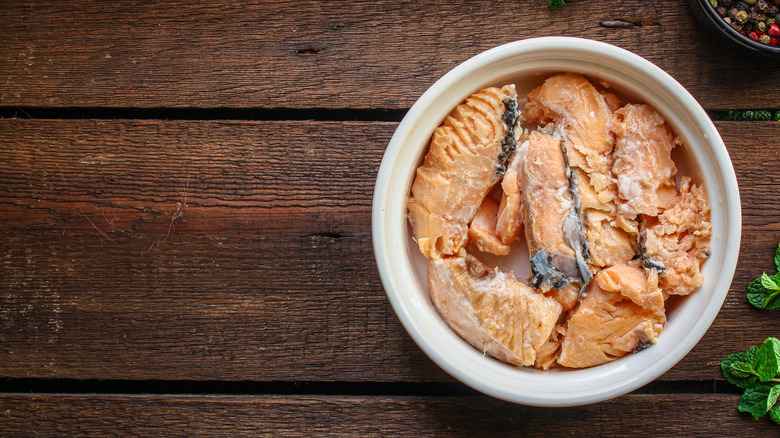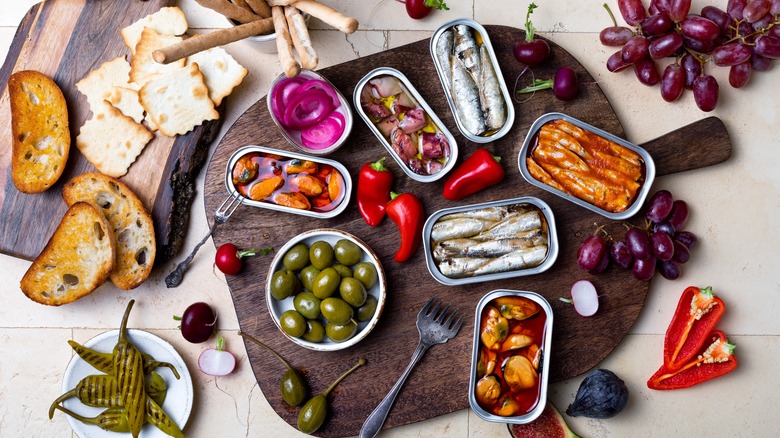Canned Tuna Vs Canned Salmon: Everything You Need To Know
Canned tuna is a familiar pantry staple, omnipresent in everything from tuna salad to tuna melts. Indeed, shelf-stable tuna is perhaps one of our favorite ways to get fish into our diets: American consumers eat an average of almost 2 pounds of canned tuna each year, or 9% of our total seafood consumption. (The only seafood beating out canned tuna are shrimp, of which Americans eat a whopping 5.9 pounds per person per year, and salmon, with 3.38 pounds per person on average.)
But tuna is far from the only fish you'll find in the canned goods aisle. Canned salmon has become a new favorite of late, and it's no surprise. Just as rich in protein and just as easy to use, canned salmon may boast its own flavors and nutritional profile (and a slightly different price point), but it's just as worthy of our attention as the familiar old favorite.
Of course, the two products do boast some similarities: Both are made with carnivorous fish that's processed and fully cooked, which means that both are ideal items to have on hand for a quick and easy meal option. They can even occasionally be swapped for one another in certain recipes. But some major differences between canned tuna and canned salmon demand a closer look. Here are all the major differences dividing these two similar products.
What is canned tuna?
One of the most popular seafoods in the world, tuna is a carnivorous fish that regularly grows to weigh several hundred pounds. Tuna boasts a meaty texture that stands up particularly well to canning, which transforms it into a fully cooked, easy-to-use pantry staple. Whether fresh or canned, tuna is low in fat and rich in protein. It also boasts quite a few essential nutrients like vitamin B12, iron, and omega-3 fatty acids. These healthy fats are known for their incredible nutritional benefits, notably contributing to improved brain health. (It's no wonder we call fish "brain food".) Omega-3 fatty acids have also been known to reduce general inflammation, and may even help reduce the risk of heart disease and metabolic disease (via Healthline).
While both canned and fresh tuna boast these health benefits, canned has quite a few advantages over fresh. An easy-to-use pantry staple, tuna has a way longer shelf life and is far less expensive than its raw counterpart. And while mercury contamination is a far greater concern for tuna than for smaller fish like tilapia, since canned tuna is usually younger than the type preferred to sell fresh, it's lower in mercury, too.
What is canned salmon?
Canned salmon might not be as widespread on pantry shelves as canned tuna, but at the end of the day, it's a fairly similar product that can be used in many of the same ways as canned tuna, such as in cold salads, patties, or fish burgers. Like canned tuna, canned salmon is a fully cooked, shelf-stable product that's rich in protein and omega-3 fatty acids, and boasts a far longer shelf life and lower price point than its fresh cousins. Canned salmon, like fresh, may be wild-caught or farmed, with wild salmon being far denser in key nutrients and containing up to three times less fat than farm-raised salmon (via Delish).
Given the price discrepancy between farmed and wild salmon, opting for canned wild-caught salmon can be a great way to access this product's higher nutritional properties without shelling out quite so much. And if the nutritional profile of the fish is your top concern, it's interesting to note that canned salmon is even more nutritious than fresh. This stems from the fact that the small pin bones in a salmon fillet soften significantly during the canning process, essentially melting into the fish and suffusing it with added calcium. This mineral joins selenium and vitamin B12 in rendering canned salmon a superfood truly worthy of the name (via Healthline).
Canned salmon is higher in fat and some key nutrients than canned tuna
Perhaps the biggest difference between canned salmon and canned tuna comes down to their nutritional profiles. While both are good sources of protein, tuna edges salmon out slightly with 21 grams of protein per 3-ounce portion as compared to just 17 grams for the same amount of salmon. Salmon comes out on top nearly everywhere else. Canned salmon contains a bit more vitamin B12 and a whopping 14 times more vitamin D than canned tuna does. It also has over 1,500mg of healthy omega-3 fatty acids per 3-ounce portion, as compared to somewhere between 1,000 to 1,500mg for tuna, depending on the species (via Verywell Fit).
But tuna isn't just a winner in the protein category. It's also lower in calories than salmon, with just 93 per 3-ounce portion as compared to 121 for salmon, a discrepancy that comes down to the higher (healthy) fat content of the latter. Tuna also boasts over twice the selenium and just over twice the niacin of canned salmon, the former of which is beneficial for thyroid, metabolic, and cognitive function, and the latter of which is known for improving blood fat levels, reducing blood pressure, and even improving skin health (via Healthline).
Canned tuna is cheaper than canned salmon
Raw, fresh tuna can be one of the most expensive fish out there, with bluefin tuna specifically fetching in the hundreds, thousands, or even millions of dollars. But when it comes to the canned stuff, there's no getting around it: tuna is a far better deal than salmon.
Canned tuna usually costs somewhere around $1.60 to $1.80 per 5-ounce can, with lower-grade tunas fetching as little as $.80 or $.90 per can. Canned salmon, meanwhile, starts at $1.88 per 7.5-ounce can, a discrepancy linked to a certain extent to the larger size of the standard can for salmon. But even if you factor in the greater quantity of fish in a standard can of salmon, it still comes out to around $.25 per ounce for the cheapest salmon, as compared to just $.16 per ounce for the cheapest tuna. And what's more, canned salmon prices can quickly skyrocket, with a better quality salmon reaching $9 per 6-ounce can. Even imported Italian tuna packed in olive oil, some of the best on the market, costs just $6.95 per 5.6-ounce can — a fraction of the cost of the priciest salmon.
Canned tuna is available in more varieties than canned salmon
Both canned tuna and canned salmon are available in different forms: they can vary depending on the species of fish that's being canned, the liquid the fish is suspended in, or even the size of the pieces or chunks in the can. When it comes to salmon, entry-level canned salmon is usually basic pink salmon, while premium canned salmon may take advantage of sockeye or chinook. The best-quality canned salmon may even take advantage of the flavor of wild Alaskan salmon. Salmon is usually canned in water, though you can occasionally find it canned in oil.
When it comes to canned tuna, you'll encounter far more choices. Skipjack is perhaps the most common type of canned tuna, seeing as it's so abundant in our oceans. It boasts a relatively soft texture, which means it's often canned in chunks, rather than whole or solid. Yellowfin tuna boasts a rich flavor particularly beloved by European brands, while white tuna, also known as albacore, is quite tasty and firm, with a mild flavor and a natural salinity. Tuna may easily be found canned in anything from oil to water to broth, and you'll find tuna canned solid, as one whole piece, or in chunks.
Canned tuna is higher in mercury than canned salmon
Both tuna and salmon are carnivorous fish, which means that mercury could be a concern. Fish can absorb mercury naturally via bacteria in waterways, and the larger and more predatory a fish is, the more mercury it is likely to contain, seeing as larger fish don't just absorb mercury in water, but also in the other fish upon which they prey. Consuming too much fish containing a high mercury load can have negative effects on brain development and can even be toxic, which is why pregnant and nursing women must be careful of consuming too much carnivorous fish (via State of Rhode Island Department of Health). But while many fish contain mercury, tuna is one of the most contaminated out there, with some species of tuna containing nearly 60 mcg of mercury per 3-ounce serving.
Luckily, canned iterations of tuna contain far less mercury than fresh, in large part due to the fact that it's usually the smaller, younger tunas that are processed in this way. Canned albacore contains about 29.75 mcg of mercury or 0.350 ppm per 3 ounces, while canned light tuna contains just 10.71 mcg or 0.126 ppm. That said, if mercury is a concern, you're much better off opting for salmon. Canned salmon contains an average of just .014 ppm of mercury, a fraction of the load of even light tuna.
Canned tuna is easier to find packed in oil than canned salmon
Tuna can be canned in anything from water to brine to oil, but the latter is perhaps the unsung hero of the grocery store shelf. While oil-packed tuna may not be the most traditional ingredient in tuna salad, once you give it a try, you'll see why so many swear by it. Not only does that added oil give canned tuna loads more flavor, but when you opt for olive oil-packed tuna, the resulting product is even richer in healthy monounsaturated fats, antioxidants, and vitamin D (via Healthline). The oil from a can of tuna boasts loads of flavor, so rather than throwing it away, cooks can save it and use it to add even more flavor to vinaigrettes for salade niçoise, add more moisture to pan-seared tuna patties, or offer an alternative to a mayo-based dressing for a classic tuna salad sandwich.
While you can also find salmon canned in oil, it's not nearly as widespread as oil-packed tuna. And even when you can find it, nutritionist Lisa Richards tells Mashed, salmon is frequently canned in vegetable oil rather than olive. Given the use of this more processed oil higher in saturated fat, oil-packed canned salmon is no healthier than water-packed — and could even be considered a worse choice from a nutritional standpoint.
Canned salmon is more sustainable than canned tuna
Rampant overfishing and rising ocean temperatures mean that it's more important than ever to source our fish and seafood sustainably. Unfortunately, over half of the tuna sold in the U.S. is considered unsustainable by industry experts. Tuna is often fished by purse seine, which can trap dolphins and other sea mammals, contributing to rampant bycatch. And while smaller, more sustainable tuna species are often preferred for canning, buying truly sustainable canned tuna requires a bit of extra work on the part of the consumer. Shoppers must be vigilant in reading the on-can labels, seeking out terms like pole-caught or troll-caught to make sure they're not contributing to the problem with their purchases.
Salmon fisheries, however, are much better managed than tuna, in large part thanks to salmon's natural inclination to return to the same place to spawn each year, which renders data collection a whole lot easier. And while salmon, like tuna, is a carnivorous predator, it eats further down the food chain than tuna, rendering it a slightly more sustainable choice. Compounded with the widespread use of sustainable fishing methods in salmon fisheries that significantly reduce bycatch as compared to tuna, salmon is hands-down the more sustainable choice.
Canned tuna has a milder flavor than canned salmon
If you prefer your fish on the less overtly fishy side, tuna might be the right choice for you. Despite its famous odor rendering it a trope of unpleasant coworker-packed lunches, canned tuna actually has a relatively mild flavor, especially as compared to other canned fish like sardines or mackerel. This holds especially true if you pick white albacore tuna, which boasts a firmer texture and perhaps the mildest flavor of any other canned tuna. Especially once it's seasoned with mayonnaise, onion, and celery in a classic tuna salad, tuna becomes so mild in fishy flavor that mistaking it for chicken becomes totally understandable.
Canned salmon, on the other hand, has a slightly more robust flavor, which should be unsurprising to anyone who's sampled fresh tuna and fresh salmon side by side. While canned salmon is a bit less richly flavored than fresh, it nevertheless boasts more savoriness and fishiness than canned tuna does — and it also proves slightly brinier than fresh salmon. Pink salmon is certainly the mildest of the lot, but it's still fairly assertive as compared to canned tuna. And as you move into more upmarket canned salmons like sockeye, flavors will become even more robust and pronounced. For some, this is a benefit, but for those who don't like particularly fishy fish, it can certainly be a deterrent.
Canned salmon can more easily stand in for its raw counterpart in some recipes
Set a plate of fresh seared ahi tuna next to a plate of tuna salad, and it would be hard to believe the main ingredient in each dish is the same. But this difference is not quite as polarizing when it comes to salmon, which boasts the same rich pink color and flaky texture, whether cooked fresh or enjoyed out of the can. Of course, we're not saying a can of salmon can stand in for a poached salmon fillet. But in some cases, it can be hard to tell the difference between fresh and canned.
Such is the case of the viral Emily Mariko fish bowl, which one TikTok user said is so good they couldn't even tell the salmon in it was canned. This holds even more true for dishes like croquettes or salmon patties, where salmon is flaked and bound with other ingredients like breadcrumbs for an even less flagrant distinction. While canned salmon is certainly more expensive than canned tuna, using canned salmon in place of fresh is a budget-friendly choice that's just as delicious and nutritious. (And the same just can't be said for swapping canned tuna in place of a piece of fresh bluefin.)
Canned tuna is more nostalgic than canned salmon
If comfort food is what you seek, canned tuna has definitely got canned salmon beat. Few are the American children who didn't grow up with fresh tuna salad on toast or a bubbly tuna melt with loads of American cheese as a convenient lunchtime offering. Tuna noodle casserole, meanwhile, is a ubiquitous warming dinner, the perfect thing to feed a crowd. Try to drum up similar nostalgic memories of canned salmon, and most Americans would end up stumped.
But just because canned salmon wasn't necessarily part of your past doesn't mean it can't be part of your future. Canned salmon is the base for flavorful and super simple salmon cakes that come together in 15 minutes or less in the air fryer. It dresses up simple pasta to transform it into a dinner party-worthy main that comes together in under half an hour. Canned salmon can also be united with smoked salmon for a flavorful play on salmon rillettes.
Canned salmon can even form the centerpiece of the latest TikTok trend: a seacuterie board. This play on the more familiar charcuterie board focuses on seafood and the perfect accompaniments ranging from crackers to raw veggies to fresh herbs. It's the ideal way to dress up the canned fish aisle and start some new culinary traditions.
